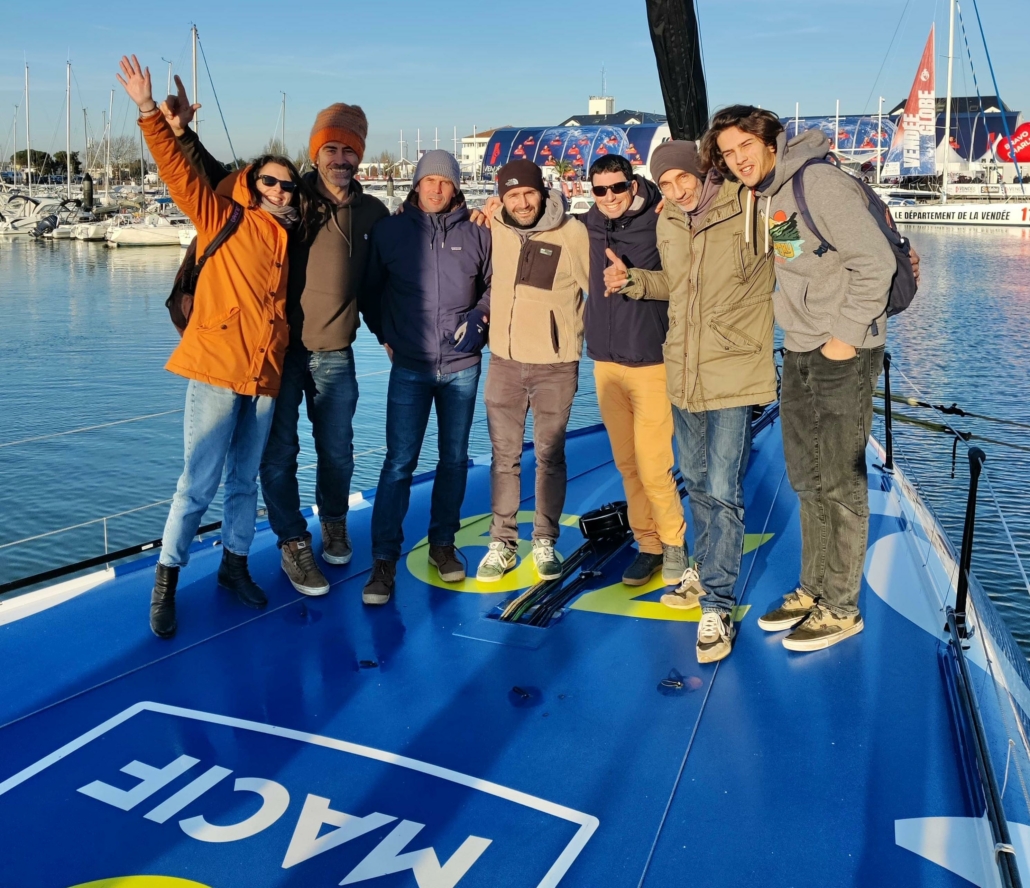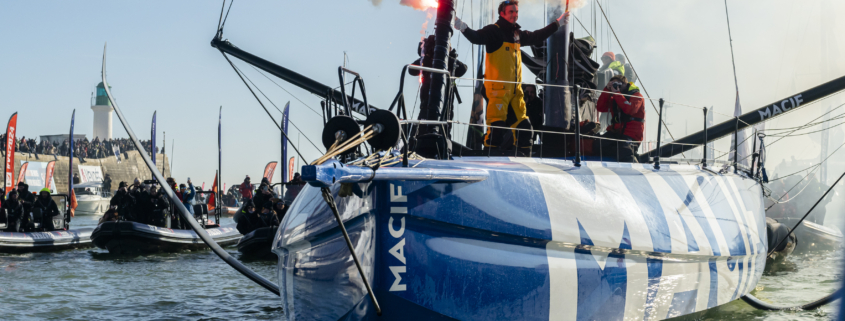Charlie Dalin, skipper of IMOCA MACIF Santé Prévoyance, wins the 10th edition of the Vendée Globe and sets a new solo round-the-world speed record!
At the helm of his boat designed by Guillaume Verdier’s team, the Norman skipper crossed the finish line in the early hours of Tuesday, January 14, 2025, at 8:24 a.m. off Les Sables d’Olonne, completing his solo, non-stop, unassisted circumnavigation in 64 days, 19 hours, 22 minutes and 49 seconds. A historic victory for Charlie, who also shattered the round-the-world speed record by nine days, previously held by Armel Le Cléac’h since 2016.
MACIF Santé Prévoyance led the fleet for most of the race, culminating in a final sprint to secure the top step of the podium. It’s a historic, inspiring, and thoroughly deserved win for this sailor, who has demonstrated remarkable consistency over the past decade — particularly aboard his last two IMOCAs, both designed by naval architect Guillaume Verdier and his team. Notably, MACIF Santé Prévoyance was the only new-generation IMOCA designed by Verdier to compete in this 10th Vendée Globe.
The Result of a Collaborative Effort
“A project like this must first and foremost satisfy the skipper! Charlie Dalin studied naval architecture and was involved in every design decision for his new IMOCA. That shared technical language made communication very fluid and helped us move forward quickly,” explains Guillaume Verdier.
“We worked hand-in-hand with MerConcept’s design office, especially with Technical Director Guillaume Combescure and Team Manager Jean-Luc Nélias. On our side, Erwan Tymen led the project brilliantly, supported by Hervé Penfornis and Romaric Neyhousser. Loïc Goepfert, Véronique Soulé, Romain Garo, and Jeremy Palmer also made significant contributions, particularly in foil design and performance analysis.”
Design Philosophy
“This boat marked a major evolution in our approach,” says Verdier. “Beyond standard design procedures, we implemented a digital towing tank simulation to model hull behavior in waves. The goal, as with APIVIA, was to create an all-around performer — efficient on every point of sail and in all sea states. Easier to handle, and more comfortable too. The living area was moved further aft to reduce pitching sensation.”
“We wanted a boat that handled Southern Ocean swells more smoothly, one that self-regulates better on foils, with less abrupt changes in trim and heel. That’s crucial, as life onboard these boats is extremely uncomfortable. There’s always a gap between theoretical performance and real-life behavior, but generation after generation, we find ways to improve. With MACIF, we preserved what worked so well on APIVIA — like its self-trimming balance — while adding new strengths.”
Hull Design
The hull now carries more volume forward and is narrower aft. “This shift adds longitudinal power, reducing nosediving and improving reactivity when the boat reconnects with the sea. The freeboards are higher than on APIVIA, partly due to updated class rules, which improve seaworthiness and limit deck water ingress.”
“We also introduced tuliping (a tulip-shaped section in the hull), first seen on 11th Hour — now Groupe Dubreuil, sailed by Sébastien Simon. This helps the hull respond more smoothly and shed water sideways. A chine or ‘step’ added amidships forward also reduces spray. These refinements enhance life onboard — and when sailors can live better, they sail better. The new 24-hour distance record on the Vendée Globe validates these design choices.”
Cockpit and Living Area
This is where the most significant changes from APIVIA occurred. “The cockpit and living space layout was mostly developed internally by Charlie and his design office. It’s an original and brilliant idea for several reasons: the skipper is more isolated from noise, the boat is more stable aft, and this living zone sits adjacent to the cockpit for easier handling. Charlie’s philosophy was to create a more comfortable and secure environment — because greater comfort translates into better performance,” explains the design team.
Foils
While the hulls of the new IMOCAs differ significantly, the foils have largely converged toward the same “Verdier-style” design: a downward-curved shaft with the radius center below and inboard after the elbow, and a tip that can be adjusted by retraction angle.
“When you move the foil in or out, you adjust the tip’s angle. Everyone’s using this general form now, though with variations in profile,” Charlie noted before the start of the race.
Structure
“We often forget the immense work done by the structural engineering teams to ensure reliability and performance,” the design office adds. “While we used to handle all calculations and construction plans internally, since 2019 we’ve collaborated with Pure Design and Engineering in Auckland — particularly with John Little, Martin Bivoit, and Minkyo Seo. We also worked with James Hamilton from Matrix Engineering in New Zealand for double- and triple-checking.”
Data Analysis
“Beyond the physics, we’ve collected years of sailing data and onboard telemetry. These insights, especially from The Ocean Race aboard 11th Hour Racing Team, have proven invaluable. These boats endure extreme conditions, so we log every ‘acrobatics’ moment to inform future design improvements. We also study degradation patterns to build more resilient boats that keep skippers safer.”
A Proven Team with 25 Years of Vendée Globe Experience
Guillaume Verdier’s design office, whose team has steadily grown over the years, is proud of its longstanding success in the Vendée Globe — with four consecutive wins by François Gabart, Armel Le Cléac’h, Yannick Bestaven, and now Charlie Dalin.

L’équipe de conception du Cabinet Guillaume Verdier aux Sables d’Olonne pour saluer la performance de Charlie @Romain Garo
Innovative Concepts Over the Years:
Planing hulls with hard chines (Safran 1, Marc Guillemot)
Highly aft-rigged masts (Safran 1)
Canting keel systems enabling versatile performance
Fuller bows to reduce heeling asymmetry (Virbac-Paprec)
The first foils in offshore racing (Safran 2 and Banque Populaire)
Contributors to the MACIF Santé Prévoyance IMOCA Design
Romaric Neyhousser, Loïc Goepfert, Véronique Soulé, Romain Garo, Hervé Penfornis, Jérémy Palmer, Erwan Tymen, Véronique Rolland, Alexis Muratet, Benjamin Muyl Design, Pure Design and Engineering (NZ), Matrix Engineering (NZ).
*Excerpts from an interview with Charlie Dalin for Course au Large magazine.



 Vincent Curutchet / Alea
Vincent Curutchet / Alea